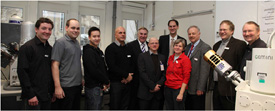Oxford Instruments NanoAnalysis, the world leader in Energy Dispersive Spectroscopy (EDS) solutions for electron microscopes, has completed the installation of its 1000th X-Max. The X-Max was only introduced to the market a little over two years ago and remains the only detector in the world that offers an 80mm2 sensor area. The 1000th X-Max was installed at Atotech in Berlin, Germany, along with three other X-Max units.
As the microanalysis community increasingly looks at features in the nanometre scale, the ability of an EDS detector to collect the reduced X-ray counts at this scale becomes critical to success. The search for accurate results becomes even more testing when microscope beam currents need to be reduced in order to preserve the sample integrity. The X-Max was the world's first "Large Area" silicon drift detector. Under the same conditions, its effective area of 80mm2 captures ten times more counts compared to traditional EDS detectors. Two years after launch, it is the only SDD detector to offer such a large area.
 The photograph shows Dr. Ralf Shulz Atotech Team Leader Microscopy (3rd from right) with Peter Clark, Global Sales & Service Director of Oxford Instruments(7th from right) in front of the new X-Max system. The 1000th unit shipped by Oxford Instruments is shown by the special gold cover.
The photograph shows Dr. Ralf Shulz Atotech Team Leader Microscopy (3rd from right) with Peter Clark, Global Sales & Service Director of Oxford Instruments(7th from right) in front of the new X-Max system. The 1000th unit shipped by Oxford Instruments is shown by the special gold cover.
Oxford Instruments NanoAnalysis Managing Director, Dr. Ian Barkshire, stated, "As a business, Oxford Instruments aims to use innovation to turn smart science into world class products, and the X-Max is a classic example of achieving what we set out to do. I am delighted to consistently hear from customers that they have achieved amazing results."
The installation took place at Atotech GmbH in Berlin, Germany, in January 2011. Atotech is one of the world's leading suppliers of integrated production systems for semiconductor and printed circuit board manufacturing. During installation the X-Max was tested and found to be well within the 124eV specification limits set for a premium detector. Dr. Ralf Schulz, Atotech Team Leader Microscopy, stated "In our business, the quality of the result is extremely important. The four X-Max detectors were chosen as they will enable us to characterise our materials faster and better than we otherwise could achieve."